Abstract
This paper focuses on scheduling a rotary injection molding machine with dependent processing times. The injection machine has n pairs of positions to process n pairs of shoes. It is rotated after every cycle time. Cycle time is the maximum injection time of the jobs currently loaded in the machine. Thus, for all practical purposes, the processing time of a job depends on the combination of the jobs currently assigned to the machine. The uncertainty of processing time makes this problem more complicated than traditional parallel machine scheduling problems. Additionally, since switching jobs leads to mold changes, set-up time is also included in the analysis. We develop a Sequential Genetic Algorithm (SGA) to identify the best schedule with regard to makespan. In this approach, multiple GA evolvers are connected by using a feeding strategy, where each GA evolver identifies the best schedule with minimum makespan for the corresponding product family. A multi-segment (product lines) chromosome representation is applied to represent the product line sequence as well as the job sequence within a product family. Furthermore, an adaptive feeding strategy is also proposed to improve results and reduce computation times. Besides SGA, we also improve the performance of a traditional heuristic procedure by proposing a minimum ΔIT heuristic approach. The experimentation is performed by using four experimental data sets with different demand patterns and nine data sets from a shoe manufacturing plant. The results indicate that our SGA provides better schedule with respect to makespan value, while heuristic procedures take insignificant time to obtain results. Another observation is that adaptive feeding strategy helps to find good results in a shorter time.
Similar content being viewed by others
References
Brucker P., Dhaenens-Flipo C., Knust S., Kravchenko S. A., Werner F. (2002) Complexity results for parallel machine problems with a single server. Journal of Scheduling 5(6): 429–457
Centeno G., Armacost R. L. (2004) Minimizing makespan on parallel machines with release time and machine eligibility restrictions. International Journal of Production Research 42(6): 1243–1256
Cheng T. C. E., Sin C. C. S. (1990) A state-of-the-art review of parallel-machine scheduling research. European Journal of Operational Research 47(3): 271–292
Cheng R., Gen M., Tozawa T. (1995) Minmax earliness / tardiness scheduling in identical parallel machine System using genetic algorithm. Computers & Industrial Engineering 29(1–4): 513–517
Cheng R., Gen M., Tsujimura Y. (1996) A tutorial survey of job-shop scheduling problems using genetic algorithms, part I: Representation. Computers & Industrial Engineering 30(4): 983–997
Damodaran P., Chang P. (2008) Heuristics to minimize makespan of parallel batch processing machines. International Journal of Advanced Manufacturing Technology 37(9): 1005–1013
Dastidar G. S., Nagi R. (2005) Scheduling injection molding operations with multiple resource constraints and sequence dependent setup times and costs. Computers & Operations Research 32: 2987–3005
Franca P. M., Gendreau M., Laporte G., Muller F. M. (1994) A composite heuristic for the identical parallel machine scheduling problem with minimum makespan objective. Computers & Operations Research 21(2): 205–210
Gharbi A., Haouari M. (2002) Minimizing makespan on parallel machines subject to release dates and delivery times. Journal of Scheduling 5(4): 329–355
Gholami M., Zandieh M. (2009) Integrating simulation and genetic algorithm to schedule a dynamic flexible job shop. Journal of Intelligent Manufacturing 20(9): 481–498
Holland J. H. (1975) Adaptation in natural and artificial systems. University of Michigan Press, Ann Arbor
Huang S., Cai L., Zhang X. (2010) Parallel dedicated machine scheduling problem with sequence-dependent setups and a single sever. Computers and Industrial Engineering 58(1): 165–174
Jia H. Z., Nee A. Y. C., Fuh J. Y. H., Zhang Y. F. (2003) A modified genetic algorithm for distributed scheduling problems. Journal of Intelligent Manufacturing 14(3–4): 351–362
Lann A., Mosheiov G. (2003) A note on the maximum number of on-time jobs on parallel identical machines. Computers and Operations Research 30(11): 1745–1749
Lee C. Y., Piramuthu S., Tsai Y. K. (1997) Job shop scheduling with a genetic algorithm and machine learning. International Journal of Production Research 35(4): 1171–1191
Liu T. K., Tsai J. T., Chou J. H. (2006) Improved genetic algorithm for the job-shop scheduling problem. International Journal of Advanced Manufacturing Technology 27(9): 1021–1029
Mandel M., Mosheiov G. (2001) Minimizing maximum earliness on parallel identical machines. Computers and Operations Research 28(4): 317–327
Min L., Cheng W. (1999) Genetic algorithm for minimizing the makespan in the case of scheduling identical parallel machines. Artificial Intelligence in Engineering 13(4): 399–403
Pinedo M. (2008) Scheduling theory, algorithms, and systems. (2nd ed.). Prentice-Hall, NJ
Radhakrishnan S., Ventura J. A. (2000) Simulated annealing for parallel machine scheduling with earliness-tardiness penalties and sequence-dependent set-up times. International Journal of Production Research 38(10): 2233–2252
Ruiz R., Maroto C. (2006) A genetic algorithm for hybrid flowshops with sequence dependent setup times and machine eligibility. European Journal of Operational Research 169(3): 781–800
Süer, G. A., Santos, J., & Vazquez, R. (1999). Scheduling rotary injection molding machines. In Proceedings of the second Asia-Pacific conference on industrial engineering and management systems (pp. 319–322).
Süer G. A., Subramanian A., Huang J. (2009) Heuristic procedures and mathematical models for cell loading and scheduling in a shoe manufacturing company. Computers and Industrial Engineering 56(2): 462–475
Süer G. A., Vazquez R., Cortes M. (2005) A hybrid approach of genetic algorithms and local optimizers in cell loading. Computers and Industrial Engineering 48(3): 625–641
Yalaoui F., Chu C. (2002) Parallel machine scheduling to minimize total tardiness. International Journal of Production Economics 76(3): 265–279
Yi Y., Wang D. W. (2003) Soft computing for scheduling with batch setup times and earliness-tardiness penalties on parallel machines. Journal of Intelligent Manufacturing 14(3–4): 311–322
Author information
Authors and Affiliations
Corresponding author
Rights and permissions
About this article
Cite this article
Huang, J., Süer, G.A. & Urs, S.B.R. Genetic algorithm for rotary machine scheduling with dependent processing times. J Intell Manuf 23, 1931–1948 (2012). https://doi.org/10.1007/s10845-011-0521-9
Received:
Accepted:
Published:
Issue Date:
DOI: https://doi.org/10.1007/s10845-011-0521-9




